Cultivation methods and precautions of silk flower

How to cultivate silk flowerLight and temperatureThe silk flower likes a warm and sunny environment and is cold-resistant and shade-resistant. Therefore, when cultivating the silk flower, it is necessary to give it sufficient light and maintain a suitable growth temperature. WateringThe silk flower needs to be guaranteed to have sufficient water during the maintenance period, but it should be noted that sufficient water should be given during the summer drought; sufficient water supply should also be ensured during the flowering period so that it can bloom luxuriantly and beautifully; in the rainy season, attention should be paid to drainage and no water should be accumulated to avoid root rot. FertilizationIn order for the silk flower to grow healthily, sufficient fertilizer and water are required. During the comfortable growing period, you need to fertilize frequently, once a month. When the temperature is high and the soil is dry, you can apply some thin fertilizer. In winter, reduce fertilization. In addition, after flowering, you can apply quick-acting fertilizer once or twice. Reproduction methodThe propagation of silk flowers is usually done by sowing, which can be done in spring or autumn, but it is difficult for them to survive, so when cultivating silk flowers, most of the time, cuttings are used. Precautions for the cultivation of silk flowerspruneDuring the growth process of silk flowers, pruning is essential, whether it is pruning overlong branches, overly dense branches, dead branches, diseased branches, or withered flowers and rainy buds. Pruning can make the shape of the silk flower beautiful, and facilitate ventilation and light transmission, so that the plant can grow and develop better, reduce the chance of some diseases and pests, and reduce nutrient consumption, so as to bloom better. Pests and diseasesSilk flowers have fewer diseases and pests, and may be attacked by pests such as scale insects, sawflies, aphids, beetles, rose sawflies, as well as diseases such as powdery mildew, black spot, anthracnose, and leaf rust. Prevention and treatment are needed according to the incidence of the disease. |
<<: Cultivation methods and precautions of weeping begonia
>>: Cultivation methods and precautions of Cape primrose
Recommend
Pictures of succulent plants snow lotus
Pictures of succulent plants snow lotus ...
What trees are suitable for planting in Ningxia? What are the common tree species in Ningxia?
Ningxia has a continental semi-humid and semi-ari...
How to plant osmanthus seedlings in pots, how to grow potted golden osmanthus
1. Potted Planting Method 1. Prepare the potting ...
How many years does it take for an olive tree to bear fruit?
Introduction to Growing Olive Trees Olive trees u...
Can peonies be grown in Guangxi?
Can peonies be grown in Guangxi? As long as the r...
The efficacy and contraindications of passion fruit, how to eat it correctly
1. Efficacy 1. Beauty: It contains rich vitamins,...
What to do if the daffodils fall
1. The temperature exceeds the maintenance requir...
How much water do gardenias need?
1. How much water should be poured Gardenia likes...
To grow a hanging plant that will grow out of the pot, you need to learn these 4 tips
If you want the love vine to bloom, these 4 point...
Why does trumpet creeper not bloom?
Reason 1: Seedlings The trumpet creepers in many ...
Which month is best to transplant blueberry seedlings?
Blueberry is a fruit that many people like. The f...
What are scale insects? Can they crawl onto humans?
1. What are scale insects? Scale insects are one ...
There are good flower fertilizers everywhere in autumn, why don’t you grab them quickly?
Leaves are fermented into leaf humus Steps: 1. Ju...
Cultivation methods and precautions of boxwood
Watering issues in boxwood cultivation Watering i...
Wand Fertilization Method
1. Application of base fertilizer The application...









